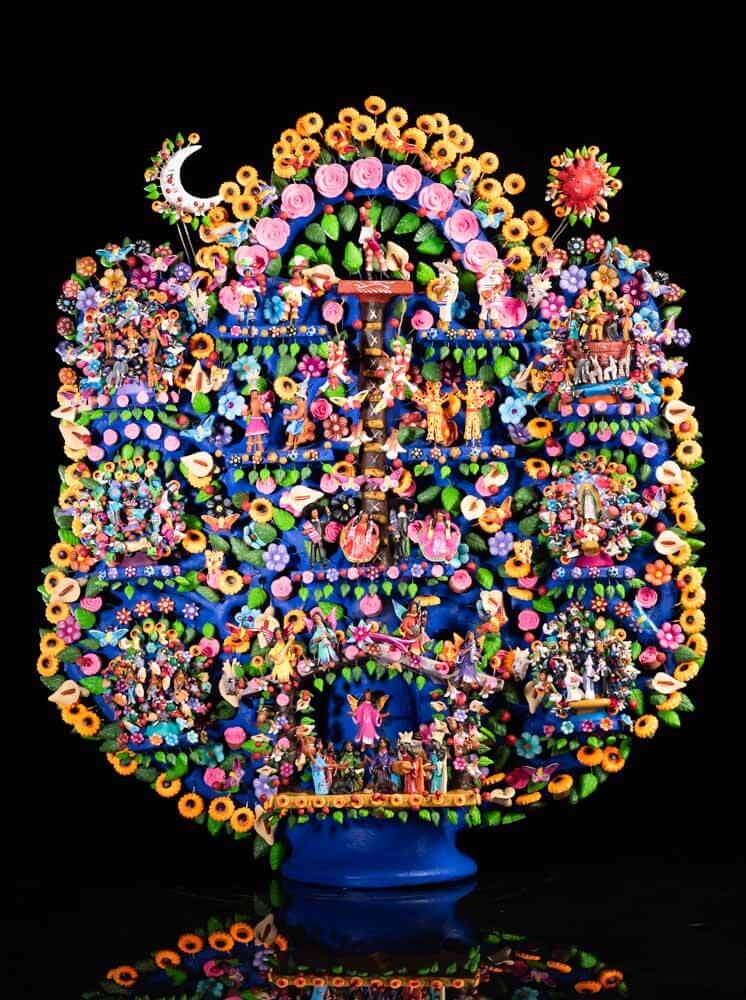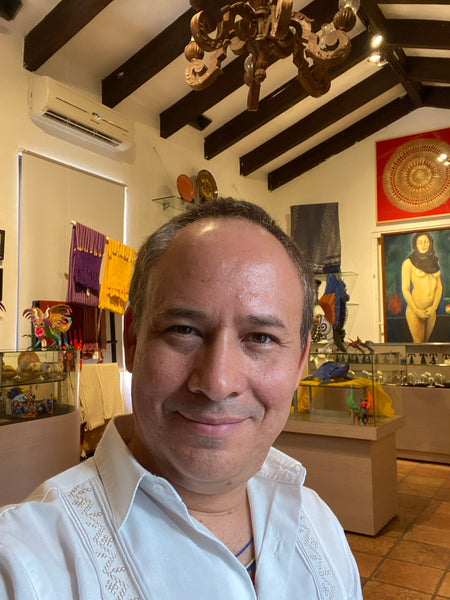WHAT IS A MEXICAN TREE OF LIFE.
Mexican Tree of Life is one of the finest pottery in the world, and one of the most popular manifestations of Mexican Folk Art.
Each tree is a molded clay candelabra, covered with multiple hand crafted and hand painted clay figures that narrate a religious passage or depict a Mexican tradition.
This type of pottery is called tree of life because the first and most popular subject depicts the story of the creation of life, according to the Genesis in the Bible with characters like God Father, Adam, Eve, the serpent and many other elements of the story.
There are other themes that determine the meaning of each tree of life such as the Nativity tree of life, Noah’s Ark tree of life, Mexican Dances, Mexican Toys, Alebrijes, and Day of the dead tree of life; just to mention the most popular themes of this amazing folk art tradition.
Genesis Tree of life crafted in Metepec by the Diaz Family.
Independently of the subject; there are elements that are always present in the decoration of a tree of life.These elements are influenced by Mexico’s pre hispanic heritage (such as the sun and the moon), It’s catholic tradition, (such as the idilic lush vegetation influenced by the garden of eden) and the agricultural history of the places where tree of life is crafted (the leafs, flowers and butterflies can be seen as leit motifs in tree of life) specially in Metepec, State of Mexico where the most important religious festivity honors Sn Isidro Labrador, saint patron of the agriculture. The main places in Mexico where the tree of life is crafted are: Metepec, in the state of México, and Izúcar de Matamoros and Acatlán In the state of Puebla.
ORIGIN OF THE TREE OF LIFE
Mexico’s great pottery tradition dates back to pre columbian times. After the conquest, most of the pottery crafted was for every day use and the highly elaborated tree of life pieces that we know nowadays were were yet far to be seen in the folk art arena.
In 1921 Mexican Painter Gerardo Murillo, Dr Atl published the famous book “ Las Artes Populares en México.” In the IXth chapter, he describes the state of Mexico as the main producer of glazed utilitarian pottery in the country; and Metepec as a town where the craft is transmitted from one generation to the next and with a mere commercial aim: “ It is not a town of artists: It is a town of crockery makers.”
Despite this lack of artistic vein described by Atl, some elements that belong to the aesthetics of the tree of life were present since the XIXth century, such as the appliqué of tridimensional figures to pulque* pitchers and the manufacture of molded animal figures such as roosters, ducks, fish, lions, dogs & mermaids. (Artes de Mexico Pp 48) As you will notice in the attached interview to this blogpost, such figures are still crafted by a few family workshops.
According to Luis Mario Schneider “ It is impossible to determine exactly when the ceramics of Metepec began to burgeon. Without Venturing precise dates, one could say that it was in the 1950´s that we saw the transformation of a strictly “pots and pans” town into a versatile and artistically creative community.”
It is quite probable that the first tree of life was created during highly creative period. However, like many folk art manifestations, we cannot accurately say who was the author of the first clay tree of life made in Mexico. Folk art is living creative process that nurtures its veins from traditions and collective processes and pieces were rarely signed at the beginnings. There is a sculpture at Ruth D. Lechuga Museum of folk Art that is perhaps one of the first pieces made with the Genesis subject: It is a tridimensional tree with Adam, Eve, a dove and the serpent dated in the 1940´s.
Vintage Tree of Life with Virgin of Guadalupe Ca1960 Metepec, Mexico. Private Collection.
FLOURISHMENT & THE INFLUENCE OF CONNOTED MEXICAN ARTISTS
During the first half of XXth century, artists like Diego Rivera, Adolfo Best Maugard, Roberto Montenegro and Doctor Atl ; with the venue of the post revolutionary Mexican Government did an intense promotion of Mexican popular & folk arts. institutions, exhibits & museums were created and a new international market of both local and international Mexican Folk art collectors bloomed.
The influence of such enormous artists like the above mentioned, refreshened the creative eye of pottery artists like Modesta Fernández, mother of the renowned Alfonso, Mónico & Tiburcio Soteno brothers.
During a visit to the Soteno’s workshop, Alfonso kindly narrated to us the encounter between his parents and the legendary Mexican Muralist Diego Rivera. Mr. Soteno kindly explained to us how the painter not only promoted his parents pottery, but also managed to display their work at the brand new National Folk Art & Popular Crafts Museum, directed by the anthropologist Daniel Rubín de la Borbolla. Some scholars state that Diego Rivera also helped to improve the paint techniques in Metepec´s pottery by making the anilines used to paint the pieces more resistant
WHAT MAKES A TREE OF LIFE STAND OUT?
There are both technical and aesthetic aspects to consider. In general terms we could say that technically, a tree of life must have a strong structure without cracks, the texture of the clay should be smooth and the figures well attached to the candelabra and the brush strokes must be precise. Aesthetically a tree of life must have a balanced shape, the figures must be as delicate and well finished as possible and the colors should be harmonious. However, there are other aspects that are more subjective, yet very important to consider about a tree of life or any Mexican folk art piece for that matter. Such subjective aspects are influenced by the structure of the family workshops and the way the craft is learned and developed:
The craftsman does not define himself in terms of either nationality or religion. He is not loyal to al idea or image but to a practice: his craft. A workshop is a social microcosm governed by laws of its own. The artisan seldom works by himself, nor is his work overly specialized as an industry. His workday is not ruled by a rigid time schedule but by a rhythm linked more to his body and sensibility than to the abstract necessities of production. As the artisan works he may talk with others and sometimes sing. His boss is not an invisible figurehead but an old man who is his master and almost always a relative, or at least a neighbor.
Octavio Paz.
As stated by Paz, most of the pottery workshops in Mexico operate within a family structure, many of them are set up in rooms or garages inside a family house and the workers are the family members or neighbors. Kids learn the craft by imitating their elders: by playing. A good thing is that clay is not expensive in its raw state and a kid can play with it as much as he or she wants. Another good thing is to have a master of folk art in the family as role model and as a partner to play with.
This ludic element in folk art sometimes gets lost. It is our belief that in such cases; the pieces produced somehow have no soul, they are mere merchandises that provide a means of existence to the maker. But not a deep artistic value. Fortunately, in other cases, such ludic approach is transformed into a refined yet playful means of expression. In such artists creativity is an ongoing process that leads to pieces that naturally stand out when displayed. At Carapan we strive to get that type of pieces for our gallery and we hope that what you find at the tree of life and Metepec section of our online store meets those standards.
My training began when I was young. I have nine siblings: five brothers and four sisters. I’m the youngest of the men and all of us work with clay. When I was little, I used to watch my brothers working. I liked to imitate them and when they’d knead the clay, I always wanted to help out. The thing is they used to play with me. I started out playing games with clay and to this day, I’m still playing.
Tiburcio Soteno. ( Interviewed by Chlöe Sayer for Artes de Mexico)
Popular Arts in Mexico Book by Gerardo Murillo, Dr. Atl
TRANSCRIPT OF INTERVIEW WITH ALFONSO SOTENO BY PORFIRIO SOSA
My parents used to bring their figures to Toluca´s City Market that took place every Friday. One of those Fridays, a man appeared and asked my parents ¿do you sell your figures?
They said yes, that´s what we are here for. And the man replied very well! I’m going to buy all of them right now, when can you bring me another batch; next week? They replied that within 15 days would be better, so they could make a good job. The man said ok, bring me another batch in 2 weeks and I will buy that one too. My parents agreed upon the deal. The man arrived to pick up his order on the scheduled date and then he asked to my parents: have you heard about a guy named Diego Rivera? They replied No, to be honest we’ve never heard that name. Then the man said: my name is Diego Rivera, I’m a Mexican painter, I paint murals, just like you make these things, I make paintings and many things. And I have news for you: A Folk Art museum is about to be opened in Mexico City and your pieces will be exhibited there. I have brought your pieces to the person that will be in charge of the museum, because I think this will be a success and he was delighted to have your pieces at the museum. Let’s hope that the museum succeeds, because if it does, you won’t have to keep selling your pieces under the markets sun anymore; please keep that in mind. He asked for my parents address in order to invite them to the grand opening, then he personally brought them the invitation to their little workshop and then he said: see you in Mexico City at such day, you must go! it will be a very important event. So they attended and they were highly surprised when they saw at the museum lobby a map with my mothers mermaid painted. That map showed all the folk art that is crafted in Mexico. My mother was extremely happy! Mr Rivera said: Your work will be here forever and people will know what Metepec is! The Museum director was the Dr.(Daniel) Rubín de la Borbolla, Mr. Rivera did the proper introduction at the event and he wished them luck with the sales and said: please bring over your pieces to the museum. And it was such a wonderful thing. Since then the last name Soteno bloomed and above all my mother, Modesta Fernández.
Metepec Folk Artist Modesta Fernández Soteno.
Photo: (Courtesy of Mr. Alfonso Soteno)







Beautiful work! Thank you.
Bravo!!! This log post makes me appreciate the Day of the Dead Tree of Life I purchased from you so much more!